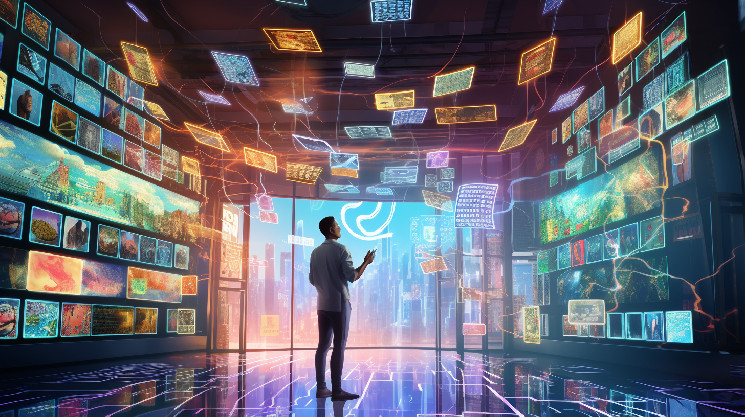Cryptocurrencies and non-fungible tokens (NFTs) are deeply interconnected. In its nascent levels, the NFT market was basically a subordinate to the broader cryptocurrency area. Its small scale meant it was closely influenced by actions and developments within the cryptocurrency market.
The NFT panorama has undergone substantial evolution over time. The as soon as fledgling market occupied a small area of interest however grew considerably, exploding into the mainstream consciousness in 2021. Catalyzed by movie star endorsements, NFTs rapidly grew out of their unique area of interest.
Collections similar to Bored Ape Yacht Membership infiltrated well-liked tradition and emerged as coveted symbols of standing and status. With the passage of time, the connection between NFTs and crypto has grow to be extra nuanced. That nuance helps the declare made by NFT trade advocates that NFTs are their very own distinct, self-sustaining market entity.
These advocates say that the advanced relationship between digital property like NFTs and standard cryptocurrencies highlights the necessity for a complete understanding and evaluation of every sector’s distinctive traits and use circumstances.
“Whereas cryptocurrencies are intently associated to different monetary devices, similar to shares and bonds, it’s believed that, at the least presently, NFTs have an artwork and neighborhood side that distinguishes them,” mentioned Daisaku Harada, chief of NFT market Unikura.
NFTs have just lately proven a noticeable decoupling from the broader cryptocurrency panorama. Downward motion in NFT costs this 12 months occurred at a later date than the downturn within the cryptocurrency market. It is a phenomenon often known as the “lag impact,” which refers to a delayed reflection of cryptocurrency motion within the NFT market.
The lag impact
In response to information from CoinGecko, the market capitalization of the cryptocurrency market peaked at over US$3 trillion in November 2021.
But, it was solely in January 2022, when the whole crypto market cap had already fallen to US$1.65 trillion, that the NFT market discovered its prime. In response to the Forkast 500 NFT Index, a gauge for NFT market efficiency, the market’s peak got here on Jan. 19, 2022.
This isn’t the one instance of erratic value conduct. Knowledge means that not solely the peaks differ, however the valleys too.
The crypto trade reached its lowest degree in recent times in December 2022. That adopted the collapse of the FTX cryptocurrency change, resulting in the present prolonged bear market. Nevertheless, the NFT house is barely now discovering its backside. The Forkast 500 NFT index worth dropped under 2,000 on Sept. 24, the primary time it has achieved so since information recording began in January 2022.
Carlos Prada, the CEO of blockchain accelerator Masterblox, believes that the market will proceed falling because the earlier surge in NFT demand was predominantly catalyzed by conventional retail liquidity.
“A discernible shift has been noticed as these traders, with a maturing understanding of the digital asset house, recalibrate their methods, usually distancing themselves from transient market exuberance. That is palpable not solely within the NFT area but additionally in emergent sectors such because the metaverse and play-to-earn ecosystems,” mentioned Prada.
“As we pivot our focus to capital influx, notably from the enterprise aspect, the present situation paints a reasonably tepid image. The inflow of capital into NFT-centric enterprises, together with these underpinning the infrastructure, seems to be negligible,” he added.
Is the worst but to come back?
The NFT sector, being comparatively nascent, stays onerous to foretell. Moreover, restricted historic information makes it tough to pinpoint any definitive insights.
Regardless of the rising adoption of NFTs by trade giants in trend, sports activities, and music, the market’s deepening troughs are trigger for concern for trade insiders. This nervousness is additional exacerbated by the looming prospect of authorized motion by the Securities and Change Fee (SEC).
In latest enforcement actions, the SEC categorized NFTs as securities in circumstances towards the Influence Idea NFT initiative and Stoner Cats, setting the stage for a brand new regulatory paradigm. This stance by the monetary overseer presents appreciable ramifications for particular person creators, companies, and buying and selling platforms working inside the area.
In the intervening time, the regulatory panorama round NFTs stays unclear. Nevertheless, entities and artists inside the U.S. could quickly have to formally register with the SEC to keep away from substantial penalties. Ought to different nations choose to mannequin their laws after the U.S. framework, the already beleaguered NFT market might meet additional headwinds.
Including to these challenges, some financial consultants are predicting a macroeconomic downturn. That might result in a worldwide recession by late 2023 or early 2024. Taking all these indicators under consideration, the longer term appears bearish for NFTs.







